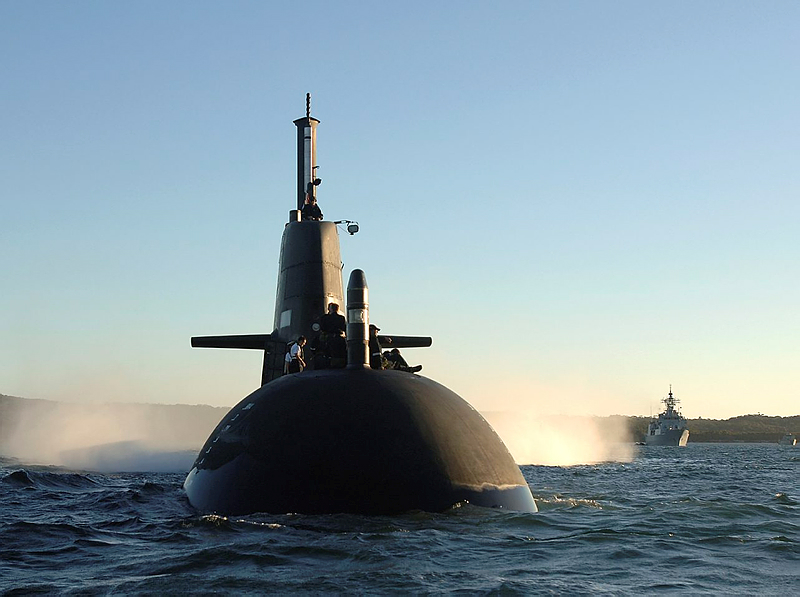
Nic Stuart’s enquiry regarding the need for submarines, asks the reader to think back to the very beginning, the 2009 Defence White Paper. Yet, 2009 is hardly an appropriate start point if we are to adequately grasp the need for submarines, or understand broader Australian maritime strategy.
The real beginning was 1901. In the years following Federation, the fledgling Australian Government sought to understand its needs for the defence of the realm. On 7 April 1902 Major General Hutton, Commandant of the Military Forces of the Commonwealth, noted:
The defence of Australia cannot… be considered apart from the defence of Australian interests. Australia depends for its commercial success and its future development firstly upon its seaborne trade and secondly upon the existence, maintenance, and extension of fixed and certain markets for its produce outside Australian waters. It therefore follows that Australian interests cannot be assured by the defence alone of Australian soil.
The Commonwealth first seriously considered acquiring submarines in 1907. Alongside the mix of destroyers and cruisers that made up the first fleet unit, Australia eventually elected to purchase three submarines, and in 1914 the first two, AE1 and AE2, arrived at Sydney. So began Australia’s nearly 100-year association with submarines, running through the J, O and Oberon classes, until Collins in the 1990s and the current debate.
Over this period some aspects of Australia’s geo-strategic situation have sharpened significantly. Today China and India are rising, competitive multipolarity is the order of the day, and a new Indo-Pacific (PDF) maritime sphere has emerged in geo-strategic thought. As the Australia in the Asian Century White Paper puts it:
Driven by Asia’s economic rise, the Indian Ocean is surpassing the Atlantic and Pacific as the world’s busiest and most strategically significant trade corridor. One-third of the world’s bulk cargo and around two-thirds of world oil shipments now pass through the Indian Ocean. Regional cooperation to ensure the safety and security of these vital trade routes will become more important over coming decades.
But other strategic factors have barely changed, or have changed in ways that require us to adjust rather than reject them outright. A century ago Major General Hutton understood that decisive outcomes could be achieved by effects applied at sea, far from our shores. In the Asian century Australian prosperity has become more not less reliant on the proper functioning of the global maritime trading system.
Indeed, we’ve entered a maritime century as much as an Asian century. Moreover, as the Prime Minister made clear in launching the National Security Strategy on 23 January, we have entered a ‘post 9/11’ era, ‘in which the behaviour of states, not non-state actors, will be the most important driver and shaper of Australia’s national security thinking.’
Australia needs a maritime school of thought to underpin intellectually a maritime strategy. The Chief of Navy, Vice Admiral Ray Griggs, recently postulated what this school of thought needs to consider:
- the sheer scale of our maritime sovereignty and the area where we can credibly exercise sovereign rights, the two of course being very different
- the increased pervasiveness of maritime trade and our national dependence on it for our ongoing prosperity
- our terms of trade play a significant role in the growth of our real gross national income
- the fundamental vulnerabilities to which our geo-strategic situation exposes us in a highly interconnected and ‘just in time’ economic system
- the importance of collaboration and cooperation in keeping our global maritime trading system free and open. No single maritime focused force can expect to achieve this mission alone.
Furthermore, ADM Griggs sees a need for reach and endurance:
It is crucial for example that we have frigates and submarines that can be operated and sustained where they need to in this global system, that we have other ISR assets that can do likewise, and that we have the ability to deploy and sustain credible and potent land forces to support the broader national objectives.
Submarines provide Australia with capabilities of stealth, reach, endurance and formidable striking power. While operating undetected, they can provide a wide variety of intelligence and enhance the range of options open to the government to protect national interests. Contrary to assertions in Nic’s article, they do have unique capabilities, including the capacity to operate in areas denied to other forces. And in a maritime region where submarines are already proliferating, our own submarines have a vital anti-submarine role.
The inclusion of submarines in a maritime strategy is a force multiplier. Operating as part of a balanced, joint, integrated and networked force, submarines will often create the conditions necessary for sea control, allowing other components of the ADF to be effectively employed. These characteristics, coupled with the submarine’s ability to deny the use of the sea to a potential adversary are of significant deterrent value
The current submarine debate in Australia is important given that the capability is a significant cost to the taxpayer. I have no issue with questioning the need for submarines. But if that question is to be asked, then the starting place for the argument should be our enduring strategic circumstances. The current fascination with platform type, place of build, engineering configuration and numbers does little to add intellectual rigour to the analysis of the submarines’ role in Australia’s maritime strategy.
In no part of Nic’s post does he address Australia’s geo-strategic circumstances, or suggest what might be included in the ‘plethora of other alternatives’. Nic makes some other assertions I’ll come back to in another post.
Captain Justin Jones RAN is the director of the Sea Power Centre – Australia. The opinions expressed in this article are those of the author alone, and do not necessarily reflect the official position of the Australian government, Department of Defence, Australian Defence Force or the Royal Australian Navy. Image courtesy of Department of Defence.

